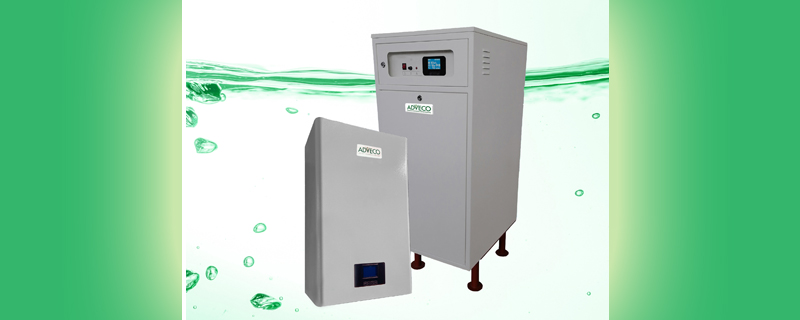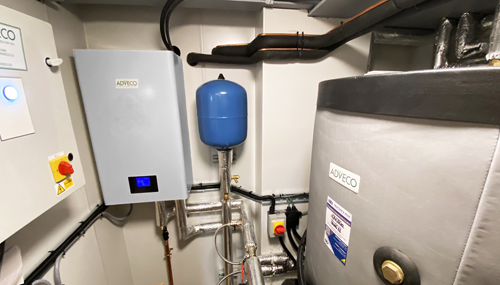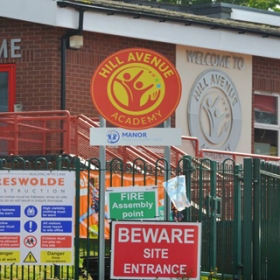Limescale protection in school electric hot water systems
As the electricity grid becomes cleaner and the potential for long-term carbon savings grows, school hot water systems in the UK are seeing an increased transition towards electric-only designs. Through the application of simple to install, cost-effective, and familiar technology they deliver lower carbon emissions in line with government calls for net zero, address regulatory changes on new gas connections and remove NO2 for improved indoor air quality (IAQ) and occupant comfort. However, there is also a growing realisation that this approach is suffering more acutely from the detrimental issue of rapid limescale generation in hard water areas.
While an optimised electric based system will be future-proofed through the incorporation of heat pump technology, electrical resistive heating remains a necessary component of many systems to deliver the high-grade heat required for domestic hot water (DHW) applications. Typically, the resistive heating is provided ‘directly’ to the hot water cylinder via an electrical immersion heater.
Electric immersion heaters have been used for many years as backup heat sources in boiler-fed indirect cylinders, a lower-demand schools applications for which they are perfectly suitable. However, direct immersion heating is not advised as a primary heat source in hard water areas for education estate applications where delivering reliability is an essential business demand.
Scale of the problem
 Approximately 65% of the UK mains water is classed as ‘hard’ due to the presence of calcium. When ‘hard’ water is heated the calcium precipitates out of the solvent as calcium carbonate, clumping together and attaching to the hottest surfaces as limescale. Within a water heater, limescale will typically form on the heat exchanger or heating element.
Approximately 65% of the UK mains water is classed as ‘hard’ due to the presence of calcium. When ‘hard’ water is heated the calcium precipitates out of the solvent as calcium carbonate, clumping together and attaching to the hottest surfaces as limescale. Within a water heater, limescale will typically form on the heat exchanger or heating element.
Variation in heat exchanger types impact the formation of scale. A direct electric immersion heater aggravates the formation of scale due to the temperature and intensity of the heating element, whereas a heat exchange coil or tube typically exhibits a much lower surface temperature and comparatively less scale formation.
These larger heat exchangers also have a greater capacity to expand and contract, causing scale to flake off as it forms, avoiding detriment to the heat exchanger. Electric immersion heaters with close, tight bundles of rods also expand and contract, but some scale cannot fall clear, becoming trapped in the rods and damaging the element.
Where limescale forms and remains on the heat transfer surface, because it is non-conductive, the surface becomes insulated leading to overheating of the element or heat exchanger. Over time this will cause it to rupture if the heat cannot be dissipated. For electric immersion hot water systems scale formation can happen in hard water areas in as little as six months so should be a major concern.
It is common for protection from limescale formation to be provided by a vigorous cleaning regime, but this option carries both a cost and system downtime that is not acceptable for many school buildings. For this reason, an approach which minimises formation of scale, reducing the need for cleaning, is more advantageous.
For many education sites neither a water softener or a scale inhibitor provides a satisfactory response, whether because of space, maintenance, downtime, or cost. Water softeners require regular maintenance, which if neglected cancels all benefits, and scale inhibitors do reduce scale formation, but do not replace the maintenance regime, nor provide enough protection to ignore possible scale formation. A better option for these sites would be to replace the immersion heaters with a low limescale forming hot water system.
The case for using an electric boiler
An electric boiler, such as the Adveco ARDENT, heats water using immersion heaters located in a small tank within the boiler housing rather than directly installed into a hot water tank. This creates a sealed ‘primary’ loop to an indirect coil in the cylinder, eliminating the common problems of direct electric heating.
The electric boiler heats the same water continuously so there is only a small, finite amount of scale in the system which will not damage the elements. The heat exchanger in the cylinder is a large coil operating at a relatively low (80°C) temperature. Extensive experience with indirect coil use in the UK has shown that scale is not usually a significant problem in these systems. The electric boiler operates at the same efficiency as an electric immersion heater (100%) and so the only overall difference in system efficiency is the minimal pump electrical consumption and a negligible amount of heat loss in the pipework.
An electric boiler hot water system will take up a little more space than an all-in-one electric cylinder, but it has more versatility and requires less clearance for the cylinder. Similarly priced to an immersion heater, an electric boiler system can cost slightly more due to the small amount of additional installation work. But with the cylinder forming significantly less scale, vastly improving reliability and drastically reducing maintenance demands, operational and maintenance savings will quickly offset any additional capital costs.
The electric boiler additionally offers a level of redundancy that is not achieved with a single immersion heater. Scale formation is significantly reduced to a level that scale control can be adopted or not, depending on other building fittings and equipment that may benefit from it.






Leave a Reply
Want to join the discussion?Feel free to contribute!